Alberta Education Assurance Survey
Grade 7 Option Selection - New to ECSD
Grade 7 Option Selection - ECSD Current Students Only!
Grade 8 Option Selection - New to ECSD
Grade 8 Option Selection - ECSD Current Students Only!
Grade 9 Option Selection - New to ECSD
Grade 9 Option Selection - ECSD Current Students Only!
Math 7 Pre Assessment
EAP Students & Application
EAP Students

Registration Information
Not Currently an ECSD Student Application
Existing ECSD Student Application
Extracurricular Clubs
Extracurricular Clubs
We have many exciting opportunities for our students (Knights) to be part of the STM community.
Knight Intramurals
Recreational Leadership students run intramurals at lunchtime for homerooms to compete against one another through various sports such as Volleyball, Dodgeball and Rounders. Intramurals are an opportunity for students to compete against their classmates in various sports. It is open to all students. The purpose of the intramural program is to provide fun, safe and structured play experiences that promote the physical, mental and social development of every child
Knight Spirit
Knight Leadership is a team of grade nine students that are eager to help plan and participate in school wide events! Theme days, movie days, and school wide homeroom competitions are just some of the fun events that Knight Leadership plans.
Knight Pride - L.I.F.E. FRAMEWORK
This inclusive group of students fosters and supports individuals within our school celebrating diversities. They come together once a week at lunch to discuss issues such as sexual orientation, gender identity, gender, body image, race, culture or language, performance in school, social rejection and peer acceptance. Our vision is to support a faithful inclusive environment. St. Thomas More shares a foundational belief that all children are loved by God, are individually unique and that the school has a mission to help each student to fulfill their God-given potential in all aspects of their person: physically, academically, socially, morally and spiritually.
School Supply List
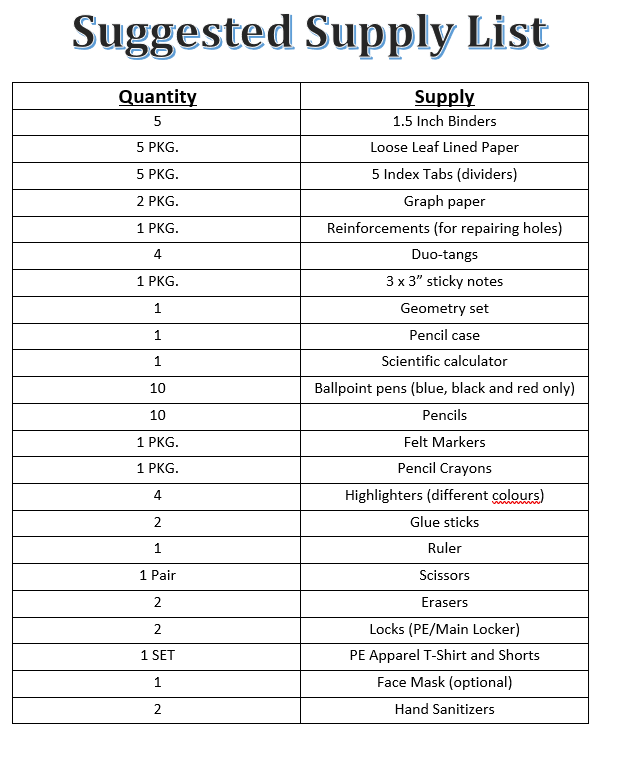
Materials for option classes will be specified by the teacher at the beginning of the school year.
*Students may have to purchase more supplies throughout the year as required to be prepared for class. In Jr. High School, there is a certain flexibility in school supplies which is why the list is merely suggested. If you believe that your child would be best served by 2 x 2.5 inch binders and to keep two or three subjects in one binder then that will work as well.
** Chromebooks, laptops or any other personal device that assists with learning
Student Conduct/Standard of Dress
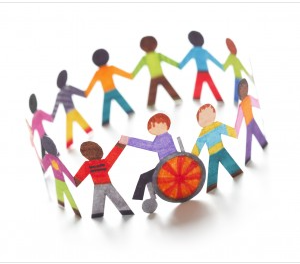
Edmonton Catholic Schools is committed to providing an inclusive, welcoming, caring, respectful, safe, and Catholic environment that promotes the well-being of all and fosters community support for achieving this goal. We acknowledge that everyone is responsible for creating and upholding an environment where all are welcome and where promoting the dignity and rights of each person is established. The following policy, administrative procedures and student code of conduct outline the expectations of all stakeholders in creating a place where everyone is welcomed and valued.
Grounded in our Catholic faith we believe:
All students are created in the image and likeness of God. As such, all human beings are inherently sacred and must be treated with dignity and respect. All efforts to support a welcoming, inclusive, respectful, safe, and caring learning environment within our school, in accordance with the teaching of the Catholic Church, remains central to our mission (Administrative Policy 138).
Guiding Principles:
Honesty takes courage and is always rooted in truth. As part of our human weakness, we all make mistakes. For growth to occur we are all called by our Heavenly Father to learn from our mistakes and be accountable for our words and actions. Integrity and trust are rooted in truth and honesty.
Respect and Dignity must permeate all that we say and do whether in our words, deeds, or actions.
Reverence of the Catholic faith is permeated in all aspects of our school life. We participate in the traditions of our faith so that we might grow as children of God. We are called to be attentive to our personal and communal Catholic identity. In times of distress, we are called to reflection and prayer so that the guiding wisdom of the Holy Spirit be ever present in all our relationships.
Responsibilities of members of our Catholic school community:
All efforts to support the inclusive, safe, and caring learning environment at St. Thomas More will be accordance with the teaching of the Catholic Church and shall be grounded in the understanding of the child (Administrative Regulation 138).
Student responsibilities (Alberta Education Act, Section 31):
- attend school regularly and punctually,
- be ready to learn and actively engage in and diligently pursue the student’s education,
- ensure that the student’s conduct contributes to a welcoming, caring, respectful and safe learning environment that respects diversity and fosters a sense of belonging,
- respect the rights of others in the school,
- refrain from, report and not tolerate bullying or bullying behavior directed toward others in the school, whether it occurs within the school building, during the school day or by electronic means,
- comply with the rules of the school and the policies of the board,
- co-operate with everyone authorized by the board to provide education programs and other services,
- be accountable to the student’s teachers and other school staff for the student’s conduct, and
- positively contribute to the student’s school and community.
Students Can Contribute to Creating a Positive Learning Environment by:
- smiling at peers and adults in our school
- speaking to their friends about their behavior (in a nice way) when they are not contributing to a welcoming, caring, respectful and safe environment
- greeting visitors to their classroom or school
- being friendly and helpful towards students that are new to the school and others
- sitting with someone who is alone at lunch, inviting someone to join games or sit with their group outside, or working together to complete a project
- keeping our school and school grounds clean and tidy
- coming to school/class on time and as prepared as possible
- treating everyone with respect even if they don’t agree with their beliefs and/or values
- having empathy for others
- following classroom and school expectations so everyone is able to learn
- Not engaging in behavior such as put downs or snickers when questions are asked in class – no one should feel afraid or nervous about coming to school.
Excerpted from The Society for Safe and Caring Schools and Communities, Series on Alberta’s Education Act, November 2014
Parent responsibilities (Alberta Education Act, Section 32):
- act as the primary guide and decision-maker with respect to the child’s education,
- take an active role in the child’s educational success, including assisting the child in complying with section 31,
- ensure that the child attends school regularly,
- ensure that the parent’s conduct contributes to a welcoming, caring, respectful and safe learning environment,
- co-operate and collaborate with school staff to support the delivery of specialized supports and services to the child,
- encourage, foster and advance collaborative, positive and respectful relationships with teachers, principals, other school staff and professionals providing supports and services in the school,
- engage in the child’s school community.
Parents Can Help Students Meet Their Responsibilities by:
- modelling kindness
- paying attention to how they talk about other children and the school in front of their children
- taking responsibility for their mistakes
- reporting any problems at school to the teacher as soon as they can. Problems are easier to solve when they haven’t been going on for a long time. The best place to start is with their child’s teacher. If parents are not satisfied with the results of this conversation, the next step would be to make an appointment to speak with their child’s principal
- Modelling peaceful problem solving when you have a conflict.
Excerpted from The Society for Safe and Caring Schools and Communities, Series on Alberta’s Education Act, November 2014
Other ways that Parents Can Contribute to a Welcoming, Caring, Respectful and Safe Learning Environment:
- speaking respectfully to and about school staff
- speaking positively about the school, staff, other students and their families in front of their child
- making appointments to ensure the person they want to speak with has sufficient time to have a focused conversation
- communicating with the teacher or other school staff – e.g. positive notes or emails to their child’s teacher and/or other school staff, positive comments when parents drop off or pick up their child
Excerpted from The Society for Safe and Caring Schools and Communities, Series on Alberta’s Education Act, November 2014
Staff Responsibilities include:
- Educate students by fulfilling the mandate of the Alberta Education curriculum and our Catholic faith
- Deliver appropriate educational programming that meets the needs of all students and enables them to be successful.
- Encourage, foster and advance collaborative, positive and respectful relationships with students, parents, colleagues.
- Model mutual respect, Catholic values and conduct that contributes to a welcoming, caring, respectful and safe learning environment
- Discipline consistently, maintaining dignity and respect
- Administer consequences for inappropriate and/or unacceptable behaviors.
- Maintain open communication, be accountable and provide assurances to students and parents about student learning outcomes
- Review conduct policy with students
- Communicate classroom expectations
- Recognize diversity and individual differences
- Respect confidentiality as appropriate
- Provide support, as appropriate, for individuals impacted by inappropriate behavior or discrimination.
Bullying/Cyberbullying Section 1(1)(d) of the Education Act defines bullying as:
“Repeated and hostile or demeaning behaviour by an individual in the school community where the behaviour is intended to cause harm, fear or distress to one or more other individuals in the school community, including psychological harm or harm to an individual’s reputation.”
Bullying can take different forms:
- Physical – pushing, hitting
- Verbal – name calling, threats, put-downs
- Emotional/Social – exclusion, rumors, extortion of money or possessions, intimidation
- Cyber – using the computer or other technology to harass or threaten
Bullying is not a normal part of growing up and it does not build character. No one should have to put up with bullying. Bullying is a learned behaviour – children and youth often learn bullying behaviours when they either experience being bullied or see it happening to others.
Bullying is different from conflict. Conflict is defined as a disagreement or struggle over opposing beliefs, needs, feelings or actions and is a normal part of life. From time to time everyone has conflicts with friends, family, teachers, co-workers. It is important to learn how to resolve conflict peacefully and recognize the difference between conflict and bullying.
Students are expected to report bullying behaviour as soon as they can after seeing it or experiencing it. Students may do this by telling an adult in the school. Students who are uncomfortable with coming forward to school personnel are encouraged to talk with parents or friends, who could then assist them in notifying the school about bullying.
Bullying or cyberbullying of students could result in an immediate suspension from school. As well, the police may become involved in the investigation of bullying incidents. Bullying is defined in law as “the repeated intimidation of others by the real or threatened infliction of physical, verbal, written, electronically transmitted or emotional abuse.” Any person who repeatedly bullies a minor (under the age of 18) in a public place could be subject to a $250 fine.
Acceptable Behaviors:
We know that most students behave appropriately most of the time. We also believe that people perform better when they know what is expected of them. St. Thomas More Catholic School is committed to providing students with a school environment that is both safe and conducive to learning. We are dedicated to teaching student’s appropriate behavior towards themselves and others. We expect students to behave in an appropriate manner, which does not interfere with the learning or behavior of others. Students are to conduct themselves in a manner that is respectful.
General Expectations for Behavior:
At St. Thomas More, we are dedicated to learning in a welcoming, caring, respectful and safe learning environment. School-wide expectations are communicated to our students by teachers in classroom discussions, by school administration in assemblies, during morning announcements, through the school communication and through our school website. We have set behavioral guidelines for the school and have asked each teacher to set programs and procedures designed to maximize student learning and responsibility. Since each teacher has a different style, specific expectations and procedures will vary from class to class.
Unacceptable Behavior:
The following are considered major forms of misbehavior and will be dealt with severely:
Defiance - Any act of defiance, that is, refusing to comply with a reasonable request from a staff member, can result in an immediate suspension.
Physical / Verbal Abuse or Harassment - Physical abuse of any type to anyone will result in an immediate suspension. Verbal intimidation or harassment will also result in an immediate suspension. At St. Thomas More, there is no such thing as “play fighting” – and therefore this will not be considered an acceptable excuse for physical contact with another student. Police may be involved if this is deemed to be appropriate by the school administration. IMPORTANT NOTE: Students who choose to watch or encourage other students in a physical fight might also be suspended from school. The fact that they have an audience encourages those students who are fighting to continue the conflict, as they do not want to "lose face" in front of their peers. Thus, the spectators are viewed by the school administration as being a major contributing factor to the continuation of the fighting, and they will be treated accordingly.
Improper or Profane Language - The use or display of improper or profane language could result in a suspension from school. Students who use profane language in addressing a teacher will be suspended from school.
Vandalism or Willful Damage to School Property - Vandalism or willful damage to school property will result in an immediate suspension and/or service within the school community* depending on the circumstances. Students will be expected to pay fully for any damage caused deliberately or through carelessness. *Service within the school community occurs when a student is assigned to do work to assist any of the adults in the school (i.e.: teachers, custodians, support staff). This is for a specific number of hours in a specified period.
Theft - Theft of property, either from the school or from another person is strictly prohibited and will result in suspension. Restoration of the stolen property is mandatory. In some instances, cases of theft are referred to the police.
Illegal Drugs or Substances - Possession or use of illegal drugs or substances on school property or in sight of school property will result in an immediate suspension and may lead to expulsion from the school. In cases of drug use, the police will be involved in the investigation and charges could be laid.
Behavior Dangerous to Self or Others - Students who engage in reckless or dangerous behavior will be suspended from school. If appropriate, the police will also be involved in the investigation.
Weapons - Possession of a weapon or presentation of any object meant to threaten or intimidate will result in an immediate suspension. Any weapons brought to school will be confiscated and turned over to the police. Police may be involved if this is deemed to be appropriate by the school administration. IMPORTANT NOTE: This rule also applies to toy knives and guns. Simulated weapons will be treated in the same fashion as real weapons. They have no place in a school environment.
Consequences for Inappropriate Behavior:
We concentrate on positive behavior and attitudes; however, there are times when a student has difficulty recognizing their responsibility as a student. In such cases, we have outlined several possible consequences for behavior. When a student behaves inappropriately, they can expect that the staff member present (teacher, administrator, teacher assistant, support & caretaking staff) will take the most appropriate action. One or more of the following can be expected to occur:
- Verbal reprimand
- Restriction of privileges and activities
- Noon hour detention of student
- Parental involvement.
- Parent-student conference with school staff
- Verbal or written apology by student
- Problem solving, monitoring or reviewing behavior expectations
- Replacement or repair of damaged property
- Temporary exclusion of student from class
- Bus suspension for students riding the bus
- In-school suspension
- Out-of-school suspension
- Referral to Attendance Board
- Behavior contract
- Involvement of outside agencies
- Involvement of Police
- Expulsion
- Record of incident retained in PowerSchool
In dealing with inappropriate behaviors, consequences are fair, but not always equal. Several factors are considered when dealing with inappropriate behavior. As might be expected, the behavior, the more severe the consequence. The context, frequency, and maturity of the students is always considered.
Repeated Violation of General Expectations:
Repeated violation of general expectations or a continual disregard of classroom rules will result in an out-of-school suspension.
Severe Breach of Conduct
Students will be suspended in accordance with Section 31 and 36 of the Education Act:
- 12. 1 Disruptive Behaviour
- 12. 2 Verbal, Physical, or Sexual Threats or Assaults
- 12.3 Harassment 12.4 Bullying – including Cyberbullying
- 12.5 Use or possession of Weapons
- 12.6 Use, possession or sale of alcohol and illicit substances
- 12.7 Vandalism or Theft
- 12.8 Any activities with criminal intent
Supports:
There are many supports available at the school through Multidisciplinary Team which includes: Instructional Coach (IC), Family School Liaison Worker (FSLW), School Resource Officer (SRO), English Language Learner Educator (ELLE), Emotional Behavioural Specialist (EBS), Therapeutic Assistant-Behaviour Therapy (TABT), Wellness Facilitator and Braided Journeys. These supports are available to all students and their parents.
Rights Afforded to All Students and Staff:
We affirm that the rights set out in the Alberta Human Rights Act and the Canadian Charter of Rights and Freedoms are afforded to all students and staff members within St. Thomas More.
Students and Staff are Protected from Discrimination:
We affirm that pursuant to the Alberta Human Rights Act and the Canadian Charter of Rights and Freedoms, students and staff members are protected from discrimination. More specifically, discrimination refers to any conduct that serves to deny or discriminate against any person or class of persons regarding any goods, services, accommodation or facilities that are customarily available to the public, and the denial or discrimination is based on race, religious beliefs, colour, gender, physical disability, mental disability, ancestry, place of origin, marital status, source of income, family status or sexual orientation.
Guiding Documents:
Catechism of the Catholic Church, The Holy See’s Teaching on Catholic Schools, Alberta Human Rights Act, Education Act, and District Administrative Policies and Regulations
Student Standard of Dress:
Students at St. Thomas More must wear:
- A shirt or the equivalent (tops) with opaque fabric that covers the front, back, and sides under the arms
- Pants or the equivalent (bottoms), and
- Shoes
- *courses or activities may require specific attire for safety or curriculum purposes (ie: CTF/CTS, PE, science labs, field trips)
Students at St. Thomas More may wear, if they are in alignment with this standard’s philosophy:
- Headwear that is specifically required for religious observance (i.e. hijab, yarmulke, turban) or for medical reasons in consultation with the principal
- Hats and toques are allowed if ears and faces are visible.
- Illustrative examples of tops: T-shirts, sweatshirts, sweaters, tank tops
- Illustrative examples of bottoms: jeans, leggings, sweatpants, skirts, dresses, shorts
- Clothing with logos or text on it that is positive in nature, respectful, or implies or encourages a healthy lifestyle/choice for children and youth.
Students at St. Thomas More may not wear:
- Articles of clothing that discriminate based on age, religion, gender, gender identity/expression, body type, race, ability, and socio-economic status
- Articles of clothing with words or text that depict or imply hate, violence, profanity, drugs/drug use, alcohol/alcohol use, sexual activity, or criminal activity.
- Hoods from hoodies or sunglasses are not allowed. School personnel must be able to easily identify all people within the school, for safety and security reasons, either in person or through security footage.
Students who have not met the standard, as outlined above, will be addressed in the following manner:
- At the first possible opportunity for a private conversation, the staff member who has identified the issue will speak to the student about the concern in a manner that respects their privacy and dignity. Care will be taken to avoid “shaming” or statements of bias.
- The student will be presented with options to bring them into closer alignment with the standard for the remainder of the school day such as:
- Wearing another article of their own clothing which they have at school that is in alignment with the standard
- Contacting a parent or guardian to bring in an article of clothing that is in alignment with the standard
- Borrowing an article of clothing from a friend that is in alignment with the standard.
Responsible Use of Internet and Software
Students will follow the responsible use of technology agreement as always outlined by the division. This includes the appropriate use of the internet for online research purposes, artificial intelligence, editing software (Grammarly), etc. to complete assessments with regards to copyright laws and maintaining the integrity of students’ authentic, independently created work. Students who are suspected of having been inappropriately utilizing online software or programs to complete assignments for them will be considered cheating/plagiarism and treated as such.
Restrictions on Personal Mobile Devices, Smartwatches, Tablets, and Social Media
To maintain a focused and respectful learning environment, the following expectations apply to all students regarding personal electronic devices:
No Device Use During Instructional Time:
Cell phones, smartwatches, tablets, and similar devices may not be used during instructional time.
Storage and Silent Mode:
If brought to school, all devices must be placed on silent mode and securely stored in lockers throughout instructional time.
Privacy-Respecting Areas:
Devices are strictly prohibited in areas where privacy is expected, including change rooms, washrooms, and private counseling spaces.
Designated Use Time:
Students may only access their personal devices for up to five minutes at the start of lunch while at their locker.
Consequences for Misuse:
Use of devices outside of these guidelines will result in consequences, which may include storing the student’s device in the office for the remainder of the school day to be picked up by parent or guardian.
Board Policy 18
Administrative Procedure 160
Administrative Procedure 351
Knight Spirit
Please come back in September for more information.
Student Services
We have many onsite services available to support student needs.
SCHOOL RESOURCE OFFICER - CONSTABLE ANDREW FREY
Hi My Name is Andrew Frey
Before policing, I worked with children and youth in a professional, faith-based capacity for six years developing a passion to serve and mentor youth to reach their full potential. I have worked with the Edmonton Police Service for over a decade and always aspired to bridge my passion for youth and role as police officer. Prior to joining the School Resource Officer team, I worked in the mental health focused Police And Crisis Team (PACT) partnered with a Recovery Alberta therapist, Recruiting and Selection, the Community Crime Management Team and general patrol in Northeast Division. I enjoy all sports but mostly basketball, volleyball and badminton. I love anything to do with music, video/board games and developing meaningful relationships bringing people together. I am excited to connect with staff and students to seek and live the excellence within.
Email: Andrew.Frey.ta@ecsd.net
Here are some helpful links:
Canadian Centre for Child Protection: https://www.protectchildren.ca/en/
Protection of Children Abusing Drugs: https://www.albertahealthservices.ca/amh/Page2547.aspx
Edmonton Police Service: https://www.edmontonpolice.ca/
Powerpoint on Parental Controls for iPhone

Wellness Facilitator - BOBBI MOORE
The Wellness Facilitator develops engaging and meaningful relationships with Indigenous students and their families. The Wellness Facilitator provides school-based intervention services for students with behavioural and emotional dysregulation as they impact their ability to learn. This position provides professional support to students, parents and school staff and community partners in utilizing strategies to support the student. The Wellness Facilitator strives to ensure balance in the students'/families lives in the areas of physical, mental, emotional and spiritual. This can be done through one on one meetings, small group work and who school initiatives.
Email: bobbi-lynn.moore@ecsd.net
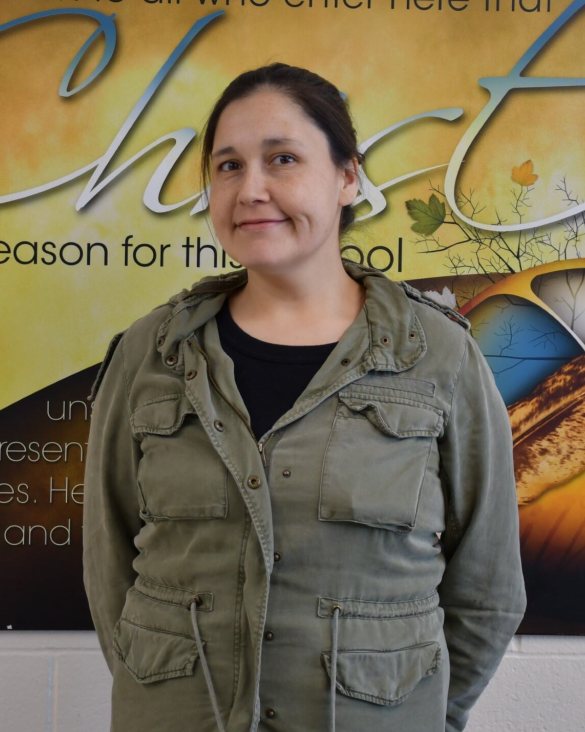
Braided Journeys Coordinator - Kat. McDermott
Email: Kathleen.McDermott@ecsd.net
Braided Journeys Student Support Centres are committed to assisting student success by cultivating a caring, welcoming, and positive place where Indigenous students see themselves, their contributions and their culture represented, respected, and celebrated. Each centre offers support, encouragement and guidance throughout a student’s educational journey.
Academic Supports:
- Course selection and study skills
- Tutoring and exam preparation
- Post-Secondary applications
- Career Development:
- Career exploration and preparation
- Post-Secondary exploration
- Scholarship applications
- Career mentorship
- Cultural Supports:
- Access to Elders and Knowledge Keepers
- Community building
- Cultural ways of knowing and land-based learning
Leadership Development:
- Social justice initiatives
- Community volunteering
- Mentoring skill development
- Transition Supports:
- Academic and social preparation for new school environments
- Bridging to Junior High and High School
- Bridging to Post-Secondary
English Language Learner Educator - Elena Lukshits
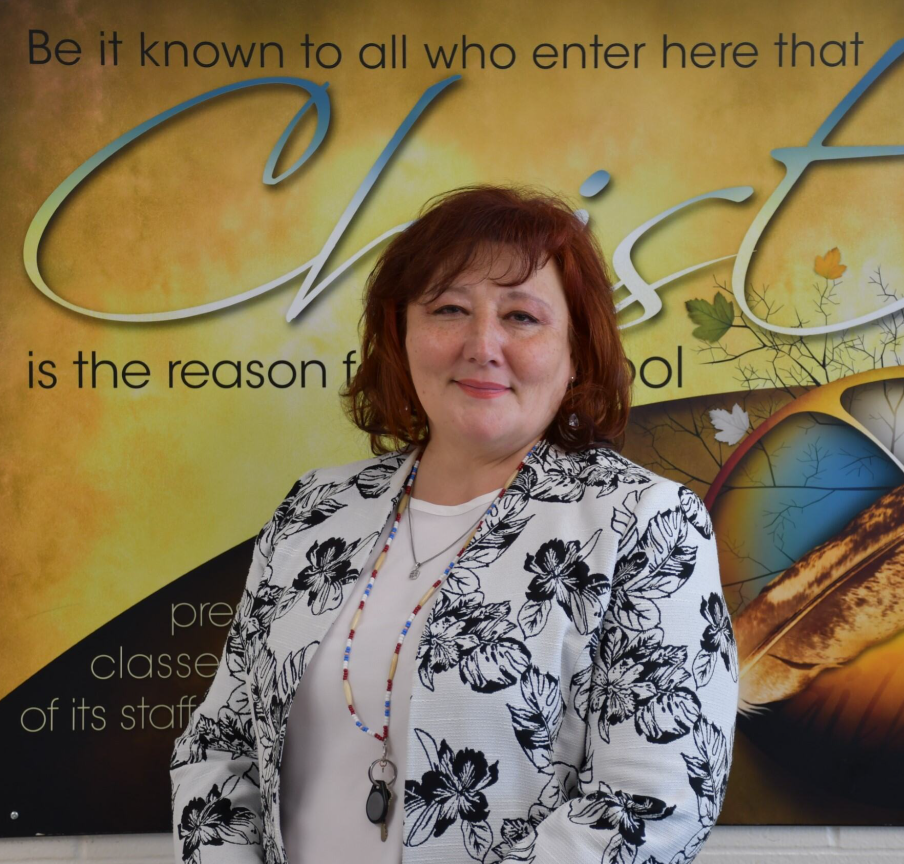
The purpose of ELLE programming is to prepare students, whose first language is not English, for the demands of high school. The ELLE program will provide English Language Learners with an opportunity to develop and extend their skills in oral and written discourse for the purposes of explaining, describing, and informing. Research shows that it can take between 5-7 years (and sometimes longer) to learn a new language proficiently. Therefore, ELL students may require more than the standard 3 years to complete their High School Diploma. Please see the ELLE for more details.
Email: Elena.Lukshits@ecsd.net
Are you new to Canada?
If you are new to Canada, please call One World...One Centre at (780) 944-2001 for more information and to book an appointment before registering at St. Thomas More.
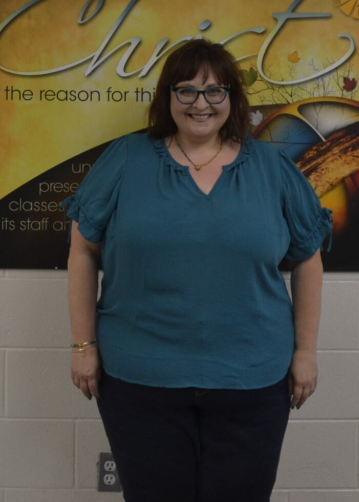
INSTRUCTIONAL COACH - Jennifer Gluwchynski
Learning coaches are teachers who are knowledgeable about inclusive education and are skilled at facilitating teacher collaboration and sharing promising practices. Learning coaches work to improve student learning by providing local support to teachers to strengthen inclusive and instructional practices.
Student Weblinks
